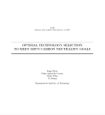
Optimal Technology Selection to Meet MIT's Carbon Neutrality Goals
The Earth’s climate is changing, and the preponderance of present-day change is associated with human activity, specifically the emission of greenhouse gas (GHG). Our planet is currently about 0.8°C warmer than it was in the pre-industrial age. The amount of CO2 in the atmosphere now is greater than at any point in the last 800,000 years according to polar ice core data, and continues to rise. The CO2 persists in the atmosphere for a very long time and the climate system responds relatively slowly, accumulated GHG emissions will result in climate changes that will last more than a thousand years. The warming climate will produce rising sea levels, coastal flooding, droughts and changes in precipitation intensity and distribution, ocean acidification, loss of sea ice, increased wildfires, and impacts on animal and plant populations.
In order to avert the worst outcomes of climate change, MIT has pledged to find affordable, equitable ways to bring every aspect of the global economy to net-zero carbon emissions no later than 2050. As the MIT community works to pioneer technologies and policies to help society combat climate change, there is a keen sense of responsibility to improve the sustainability of our campus and use it as test bed for change. For this purpose, MIT has set a tangible goal of achieving net-zero direct emissions (scope 1 and scope 2) by 2050. Our project objective is to identify a viable way forward that meets MIT’s carbon goals while minimizing cost and accounting for social disruptions. MIT has achieved around 10% of total GHG reduction in 2021 compared to 2014. However, positioned at the leading edge of technology, MIT’s energy demand is not likely to reduce significantly, and the need to replace Central Utility Plant (CUP)’s natural gas consumption system with reliable and sizable clean energy sources poses the biggest challenge ahead. Our team’s approach is to build an optimization model with reasonable estimates of the emissions reduction potential and the estimated cost curves for each technology to minimize the overall cost in achieving carbon neutrality by 2050.


